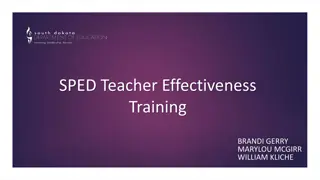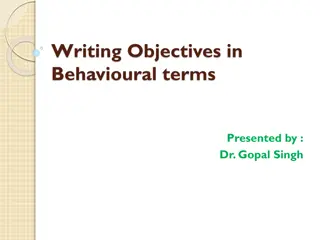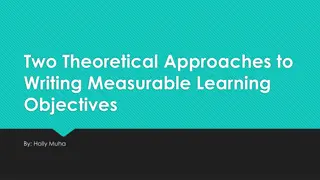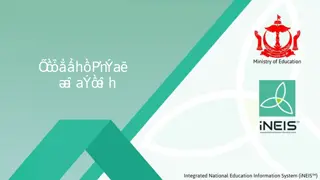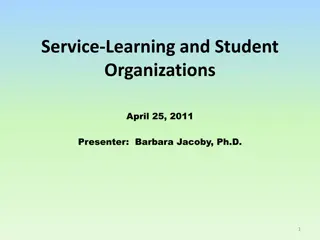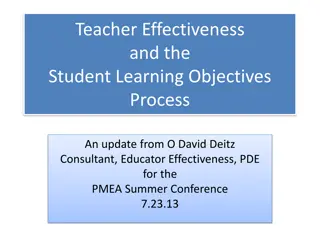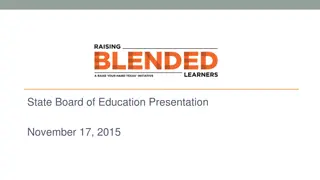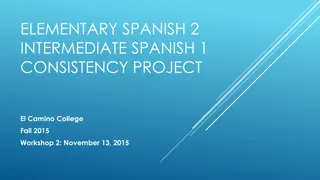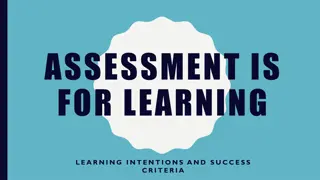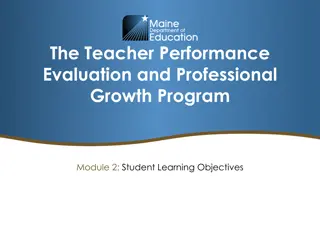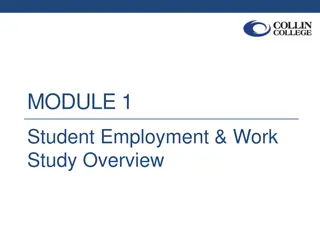Student Learning Objectives - SLO Process Overview
Explore the Student Learning Objectives (SLO) process including drafting objectives, selecting assessments, monitoring student progress, and analyzing data to determine if objectives are met. Key questions for teachers and understanding baseline data are also discussed as part of the process. Teachers are guided on SLO development with or without teams, emphasizing collaboration and data analysis for effective student learning outcomes.
Download Presentation

Please find below an Image/Link to download the presentation.
The content on the website is provided AS IS for your information and personal use only. It may not be sold, licensed, or shared on other websites without obtaining consent from the author.If you encounter any issues during the download, it is possible that the publisher has removed the file from their server.
You are allowed to download the files provided on this website for personal or commercial use, subject to the condition that they are used lawfully. All files are the property of their respective owners.
The content on the website is provided AS IS for your information and personal use only. It may not be sold, licensed, or shared on other websites without obtaining consent from the author.
E N D
Presentation Transcript
Student Learning Objectives The SLO Process Student Learning Objectives Training Series Deck 3 of 3
Review and Preview We have covered: An introduction to Student Learning Objectives. The components of a Student Learning Objective. The template for communicating Student Learning Objectives and supporting implementation tools. Next, we will cover: The process for developing Student Learning Objectives. The process for gathering and analyzing student performance data.
The SLO Process: An Overview Review Course Objectives & Standards with Colleagues; Collect & Review Baseline Data Draft Learning Objectives & Select Assessment(s) to Measure Student Progress Review Learning Objectives & Selected Assessment(s) with Evaluator Check Progress Toward Goals Teacher & Evaluator Review Student Performance Data & Determine if Objectives are Met
Key Questions for Teachers Through the SLO Process, teachers become fluent in the answers to the following questions: What do I expect my students to learn during their time in this course? How will I know if they ve learned it?
Teachers SLO Development Process Teachers with teams: Teachers without teams: - Review the standards with grade- level or content team. Analyze baseline data and student performance trends. Select common measure(s) for student learning. - Review the standards with teachers across LEA network or Collaborate with teachers from other grades/subjects within the LEA. Analyze baseline data and student performance trends. Select measure(s) for student learning. - - - - -
Understanding Baseline Data Baseline data that is useful for understanding students prerequisite skills and content includes, but is not limited to: beginning of course diagnostics and / or performance tasks, prior year tests, tests in other subjects, teacher-, school- or state generated tests, student grades in previous courses, student transiency rates, student behavior data, Individualized Education Plans.
Selecting high quality assessments (or other measure of student performance) is an integral component of the Student Learning Objective process.
Setting SLOs Identify Team Priorities & Assessments July - August - September Set & Share School Prioritie s Draft SLO Identify Class Priorities Student Data Approved SLO School Strategic Plans Set SLO Teacher Evaluator (& Supporting Leadership) Academic Data System Non- Academic Data System Teacher Teams
Monitoring SLOs Interventions & Support (On-going) Revise SLO (If Necessary) Mid-Year Conference January February Data Analysis (On-going Process) Progress Towards SLO Approved SLO Monitor SLO Academic Data System Non- Academic Data System Teacher Teacher Team Evaluator (& Supporting Leadership)
Evaluating SLO Attainment Year End Conference Adjust Professional Growth Plans (as necessary) Review Summative Data Collect Summative Data April - June Professional Growth Plan Progress Towards SLO Evaluate SLO Attainment SLO Attainment Rating Evaluator (& Supporting Leadership) Teacher Team Academic Data System Teacher Non- Academic Data System
The process for setting Student Learning Objectives emphasizes the importance of collaboration to establish long-term, measurable, academic goals for their students.
Learn More About SLOs Please visit http:// for more information about Student Learning Objectives, to see SLO samples and find tools to aid in implementation.


